« April 2013 | Main | June 2013 »
May 30, 2013
Sadako
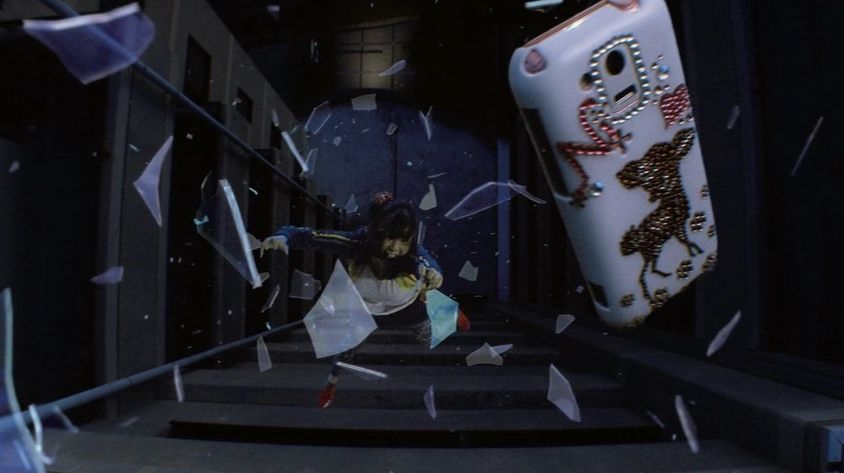
Tsutomu Hanabusa - 2012
Well Go USA Entertainment Region 1 DVD
Even though there is reference to the set-up of the first film, seeing the original Japanese version from 1998 nor the 2002 Hollywood remake is necessary to enjoy the continuing story of the long haired girl who lived in a well, who kicked off the boom in Japanese horror movies. Watching a 2D version of a film originally shown in 3D, I can only imagine what it might have been like to see that long hair spilling out, or that bony arm stretching towards the camera. Even if Sadako doesn't approach the kind of of artistry or pervasive spookiness found in Shock Labyrinth or Tormented, it offers a few visual pleasures. The story, by the way, is by Koji Suzuki, the author of the source novel and several sequels.
The biggest stumbling block is, if you knew that watching a certain video is connected to a history of people committing suicide, why are you watching it? Apparently curiosity does get the better of several people. An artist accused of plagiarism decides to make his suicide a live online event, and at the same time offer his life to the revival of Sadako, the girl in the well. His aim is to eliminate all human life, a disproportionately extreme reaction to some online criticism. Those dumb enough to look for the "cursed video clip" find Sadako emerging from their video screen to take them to their respective deaths. Sadako is in search of the perfect body to take over, which happens to belong to the young and pretty teacher, Akane.

There is some humor as the middle aged lead detective, Koiso, investigating the rash of suicides, finds himself over his head regarding the language of contemporary technology. Sadako frequently haunts Akane, appearing on computer screens as well as the larger screens that appear on buildings, and even the side of a truck. Koiso remains unconvinced until his junior partner investigates the video, and more clues are revealed in the artist's studio.
Aside from hands and hair popping out of screens, there is lots of shattered glass flying around. There are also lots of flying insects, they look like butterflies, or more precisely, the basic shape of butterflies, white and black, but not detailed. What I like about 3D movies is when strange or scary stuff seems to come toward the viewer. And for those more sensitive viewers, most of what goes on here is more strange than scary.
The biggest mystery is: who is the landlady who rented out the artist's studio. While the two detectives are checking out the basement pad, she comments on how everything in life is artificial. She pops up again, incongruously, near the end of the film. Is she a part of the sequel that is currently in the works? And for that matter, who is the actress in that role?

Posted by Peter Nellhaus at 07:32 AM
May 28, 2013
The ABCs of Death

"F is for Fart"
Multiple directors - 2012
Magnolia Home Entertainment Region 1 DVD
I'm not entirely sure if there is any way to approach The ABCs of Death in more than a general way. While the portmanteau horror film has been a well established staple of the genre, it's a bit easier to critically assess a film with three different directors, such as Spirits of the Dead, or four, such as the Thai 4bia, or even five as in the classic of the bunch, Dead of Night. What we have here is a much broader mix, with twenty-six filmmakers, one per letter, with a variety of styles, including a couple of animated films. What unifies most of the work here is a penchant for very black humor. As the filmmakers were given total freedom to within the constraints of making a story related to a letter, and keeping within a very short running time for each film, there was also a tendency towards, shall we call it, bathroom humor (and horror), of the most anal kind.
My own favorite episode was "O is for Orgasm", what the French refer to as "the little death". Bruno Forzani and Helene Cattet's style was already recognizable from their debut feature, Amer. It's mostly close-ups of a woman's face, bubbles emerging from her mouth, and various sounds associated with sex. It's also the most abstract film, using a film language more frequently employed by "experimental movies" from the Sixties, which might also explain why I liked it the best.

"O is for Orgasm"
Usually known for his stories about people with weapons replacing body parts, Noboru Iguchi's "F is for Fart" is about the aroma of love. A flatulence prone high school girl finds a kindred spirit in her youthful teacher, Miss Yumi. Love is a gas that absorbs the two women in an intestinal embrace some might find hard to digest.
"S is for Speed" is effective enough in its subject matter. The kind of speed focused on here is obvious enough that I'd rather not be a spoiler here. What I can say is that Jake West did a nice turn here with a small nod to Ingmar Bergman's Seventh Seal, with death making a visit in the scrub desert.
Thomas Malling's "H is for Hydro-Electric Diffusion" tries to be the live action version of a Tex Avery World War II era cartoon, with an actor dressed as a Bulldog soldier entertained by a showgirl fox who reveals herself to be a Nazi. It probably seemed like a good idea at the time.
Xavier Gens' "X is for XXL" is the most serious of the films in dealing with female body image. An overweight woman, subjected to verbal abuse from those passing her on the street, as well as the constant stream of advertising, takes a very radical step in reducing her fat. This short may well serve as a wake up call to those who put a premium on being young and thin.
I'm not going to do a run down on all twenty-six films here. As can be imagined, the overall work is uneven, with some films markedly better than others. The responses of viewers will also vary. What is praiseworthy is that there is some sense of inclusiveness with a global mix of filmmakers, and the participation of two women, the previously mentioned Helene Cattet, and Angela Bettis. As far as people learning their ABCs, viewers will have the opportunity for more study as a sequel is already in the works.

"S is for Speed"
Posted by Peter Nellhaus at 07:12 AM
May 26, 2013
Coffee Break

Eriko Sato and Mikako Ichikawa in Cutie Honey (Hideaki Anno - 2004)
Posted by Peter Nellhaus at 08:23 AM
May 24, 2013
This Girl is Badass

Jukkalan
Petchtai Wongkamlao - 2011
Magnolia Home Entertainment Region 1 DVD
One of the more fun films I saw in Thailand was Bodyguard 2, written, directed and starring Petchtai Wongkamlao, better known as Mum Jokmok by his Thai fans. I'm not sure how well Mum's new film is going to play for most North American viewers, but I had a good time here. Hollywood could probably learn something here, with some imaginative action scenes, truly tasteless and simultaneously hilarious jokes, and kickboxing midgets, all in one modestly budgeted movie! And who needs special effects when you have a crew of gifted stuntmen and women riding bicycles, leaping about, and taking and receiving body blows.
And then there's Jeeja. Don't bother telling me about the Hollywood actress of the day who took a few months to train for an action role. Jeeja Yanin trained for years before her debut in Chocolate. Mum crafted the film especially for her, so Jeeja has the opportunity to have a leading role. The original Thai title is the name of Jeeja's character. If you've seen Jeeja previously, you know what she's capable of as a martial artist. Here she does stunts with a bicycle including using it as a weapon against a gang of bad guys.

There is some kind of story here, with Jeeja as a bicycle courier, doing deliveries for two rival gangs. She lives with her "uncle", played by Mum, and has a crush on the handsome musician next door. All of this is besides the point, which is to allow a series of goofy situations with even goofier characters. There's one gangster who sings his own theme song upon entering a room, the sartorially challenged owner of the bicycle courier service, and a would-be suitor who, as one joker would put it, has a face for radio; Almost nothing is sacred here with the exception of Mum's character, a video store owner, pointing out that everything in his store is legal. And if you think the boast of the guy who proclaims that he'll be selling DVDs of movies released in theaters earlier in the day is some kind of exaggeration, I can tell you about seeing DVDs of Hollywood movies even before they hit U.S. theaters. Some of the humor here is aimed at cliches about life in Thailand.
That suitor gets the worst of Mum's verbal barbs, being called "Dog phlegm", among other niceties. There are even a couple inquiries as to whether he's the placenta and the actual baby is somewhere else. Yes, Mum's sense of humor is unfiltered, and some of us like it that way. One of the funnier sight gags involves a hood pulling a knife out of his leg, flinging it away, only to have it ricochet against a warehouse pillar and plunge into his arm. Yeah, it's rude and crude, but also truly entertaining.

Posted by Peter Nellhaus at 06:55 AM
May 21, 2013
Becoming Traviata

Traviata et Nous
Philippe Beziat - 2012
Distrib Films
Well, yes, I'm finding myself outside my usual zones here, as I don't cover many documentaries, much less one about the making of an opera. I would have felt less like an outsider had this documentary flashed the names of the principle artists who appear here. Most people will be able to figure out that Natalie Dessay is the main performer who we see mostly in rehearsal, and that Jean-Francois Sivadier is the director, and that the guy addressed as Ludovic is Ludovic Tezier. Those with little or no familiarity with those currently working in opera are left in the dark.
What I did like is that, even fleetingly, Beziat acknowledges some of the behind the scenes people that make up a production. Several of the opening shots are of a workshop, with rows of paint buckets and brushes. A pair of craftsmen repair a chandelier first seen illuminated, hanging from a tree. While Dessay is rehearsing, a young woman is sweeping the floor. One woman is cutting cloth, later seen as part of the costume of a chorus of gypsies.

The original French title is a bit puzzling. Translated as "Traviata and us", who is "us"? Even a little bit of geographic context might have helped in letting the audience know that there is an international crew working in Aix-en-Provence, France, on a 19th Centry Italian opera produced in a contemporary setting. There are suggestions that Dessay finds her role at Violetta challenging, to the point where she'll grab any opportunity not to rehearse. For someone like myself, there are more questions than answers as to what makes the role of Violetta difficult, and does Sivadier's putting the opera in modern dress make Verdi any more meaningful to a contemporary audience?
Some of the music should be familiar, even for those with the most casual acquaintance with opera of any kind. The story of La Traviata, while not mentioned in the film, would be known to those who've seen Greta Garbo coughing herself to death in Camille. Philippe Beziat makes some interesting choices so that we see some of the opera fragments in various stages of development, while the what we hear is one version of the performance. And there are, to be sure, some nice moments, particularly between Dessay and Sivadier, alternating between artistic alignment and moments of friction. There were times when I wish others, aside from one of the production assistants, had been addressing the camera about the opera and the artistic process involved. Were the viewer not kept at arms length for most of this documentary, this would have been more truly about La Traviata and "us".
Posted by Peter Nellhaus at 08:32 AM | Comments (1)
May 19, 2013
Coffee Break

Keenan Wynn, Shelley Winters, Gary Merrill and Michael Rennie in Phone Call from a Stranger (Jean Negulesco - 1952)
Posted by Peter Nellhaus at 08:21 AM
May 16, 2013
Nightfall
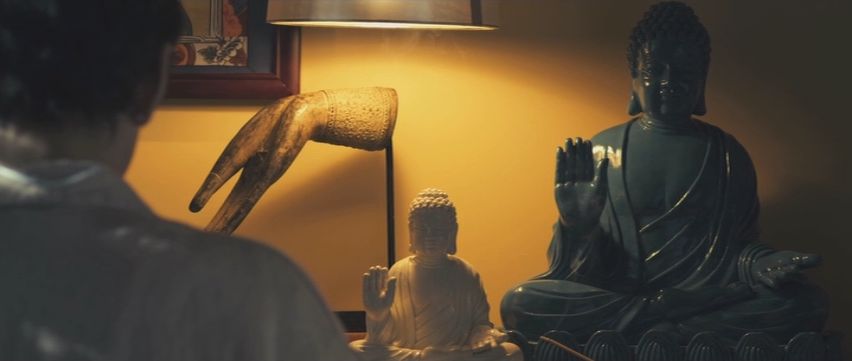
Daai deoi bou
Chow Hin Yeung - 2012
Well Go USA Entertainment Region 1 DVD
You'll have to really pay attention to catch quick glances of movie posters at the female detective's apartment. I spotted posters for Vertigo and The Long Goodbye. Add to that an English language title shared with Jacques Tourneur's film from 1957. What connects Chow's film with these past works is the attention to the psychology of the characters. There is also some high tech electronic stalking reminiscent of Coppola's tangentially noir The Conversation. Like classic film noir, this is a film that's less interested in crime than in slowly peeling away family secrets.
Nick Cheung puts in a forceful performance as Wong, a man just released after serving twenty years in prison for rape and murder. Cheung doesn't speak at all, and it isn't until about the forty-five minute mark, when undergoing interrogation from a grizzled Simon Yam, that you realize that he can't speak. On his first night out of prison, Wong is eating an ice cream cone, while observing young women, pretty with short dresses, enjoying Hong Kong night life. There is a ravenous look on Wong's face that is clearly hungry for more than ice cream.
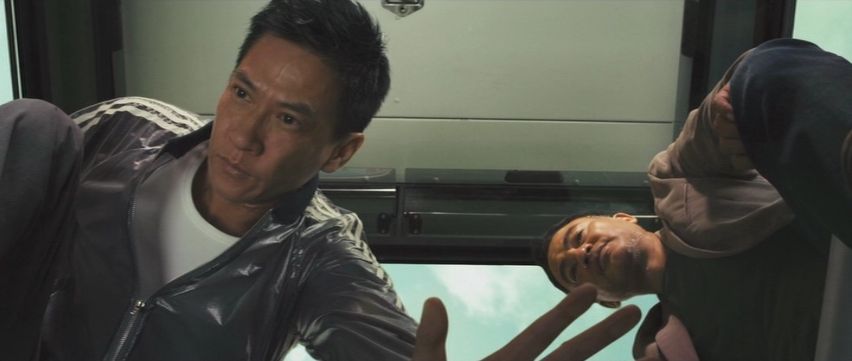
There is a murder of of a prominent musician that appears to be an act of revenge by Wong. Detective Lam, interested in reopening closed cases sees connections that others miss. But the real heart of this film is about prisons, real or psychological, imposed by others, and the fragile nature of relationships between fathers and daughters. Vertigo is probably the most famous example, but part of the story here is built on two identical looking women.
Some viewers may get vertigo from Nightfall's outstanding set-piece. Lam and Wong go to Lantau Island, a tourist attraction that Wong visited in the past. The two are in one of the cable cars, high above ground. These cable cars have clear glass floors. Lam and Wong get into a fight in this very enclosed space, with gun shots piercing the windows and floor. A glass floor with cracks and bullet holes does not engender much confidence in a safe ride when you're suspended several hundred feet above a forest.
A film that is in part about musicians, the score by Shigeru Umebayashi is especially unusual for a mainstream Hong Kong film, with one of the major themes played by a dissonant violin. This is the second film for both Chow and his screenwriter Christine To. An added bonus is a brief appearance by Gordon Liu. In seriously bad health for over a year now, as far as I'm concerned, even a cameo by Liu is pure gold. Some of the brutality in the opening scene, a fight among prisoners in a shower, might put off some viewers. There are moments in Nightfall that play more like a horror movie than a crime thriller. Then again, the director of the older Nightfall worked famously in both genres. I'd prefer to think that this is more than coincidence.
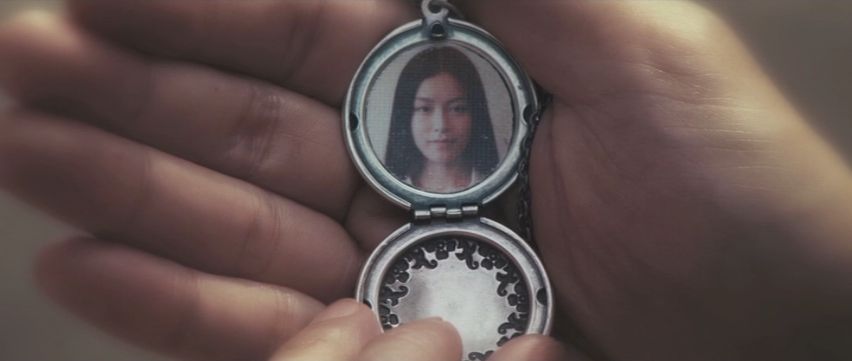
Posted by Peter Nellhaus at 07:12 AM
May 14, 2013
A New Kind of Love

Melville Shavelson - 1963
Paramount Pictures Region 1 DVD
If you haven't seen the poster for this year's edition of the Cannes Film Festival, I'm including it here at the bottom of this post. It was a publicity shot of Paul Newman and Joanne Woodward shot during the production of A New Kind of Love. A similar image was used for the movie's poster, also included here, probably using that photo as a guide. It's a great photo. It's also one of those rare images still looks fresh. If you didn't know who was in the photo, it might be hard to guess that it was photographed fifty years ago. It's also an image that's not in the movie.
You want to see a hip movie with Paul Newman and Joanne Woodward in Paris? That would be Paris Blues with Newman and Sidney Poitier as expatriate jazzbos, under the direction of Martin Ritt. Even the New York Times' Bosley Crowthers concluded, "Mr. Shavelson and his hardworking troupe and cameraman have strained mightily but their New Kind of Love is hardly new and only fitfully funny or farcial." And time has not made this film look any better than it did in 1963.

The bright spot is Joanne Woodward in the first half of the film. As the "designer" of knock-off couture for a New York City department store, Woodward with her short hair, masculine suits, cap and sunglasses rocks the androgynous look so well that Tilda Swinton should watch this movie, and take a few notes. Woodward is much sexier here than when she finally succumbs to appearing more traditionally feminine as a means of turning around her life as a "semi-virgin". And if some of the comedy here doesn't make you groan, there's the premise that a successful professional life notwithstanding, it's every woman's goal to get married.
The rest of A New Kind of Love offers a tourist's view of Paris and French culture. Having Maurice Chevalier appear to sing and dance excerpts of his greatest hits solidifies this as a Hollywood version of France. Character actor Marvin Kaplan, as a Paris based American Journalist, offers some genuinely amusing moments. Otherwise, much of what passes for humor is often smarmy. It doesn't help that as keeping with the production code of the time, there are a couple of scenes in a strip club which reveal no more skin than can be seen in a movie like Bikini Beach. There is the brief exception with a strip tease involving an umbrella that glows in the dark. The topical humor is so dated that I'm certain anyone under the age of fifty will be asking, "Who's Huntley Brinkley?".
With all the stories about the Cannes poster, I have yet to see anyone mention the name of the original photographer. Sure, the image was redone for the festival, but the guy who was on Paramount's payroll should get his due. I don't know of anyone who has seen the poster who doesn't love it. If anything, this is a reminder about why film scholarship is more than trivial pursuit - even a forgettable movie can be the source for one unforgettable image.

Posted by Peter Nellhaus at 08:13 AM
May 12, 2013
Coffee Break

Paul Newman and Marvin Kaplan in A New Kind of Love (Melville Shavelson - 1963)
Posted by Peter Nellhaus at 08:10 AM
May 09, 2013
Back to 1942

Yi Jiu Si Er
Feng Xiaogang - 2012
Well Go USA Entertainment Region 1 DVD
The history lessons in Back to 1942 are not exclusive to a specific place or time. While the subject is about a major famine in Henen Province, China during World War II, the human and political aspects have more universal resonance. To watch this film and think "it can't happen here" would be to miss the point, given recent history in the U.S. in the wake of hurricanes and other disasters.
This is not an easy film to watch. Feng attempts to work out a balance between the more personal story of the ill-fated journey of a Henen family with the various historical forces at work. At almost every turn, people make hard choices. Feng shows a degree of sympathy for Chiang Kai-shek, who might have been able to step in earlier had he been better informed about the situation. On the large scale, there is the conflict between military and humanitarian needs, feeding an army fighting the Japanese or taking care of a civilian population of thirty million. On a more intimate level, people argue over small amounts of grain, women are sold into prostitution to help feed other family members and as a way of survival, and refugees are caught between various governmental agencies that can't or won't help.

This is the third of Feng's big budget films concerning 20th Century Chinese history, following Assembly and Aftershock. The two familiar star names here, Tim Robbins and Adrian Brody essentially have supporting roles. Robbins plays the part of Bishop Thomas Magen, who had a Catholic mission. Brody's is the more significant, as journalist Theodore White, who covered China for Time magazine during World War II, and wrote a book about the Henen famine. Even the casting of two Oscar winners cannot overcome the indifference towards Chinese films by most U.S. moviegoers. While Brody does bring sincere earnestness to his role, Robbins adds very little here.
The real star here is Zhang Guoli as Master Fan. The film follows Fan's odyssey from prosperous landowner and patriarch to lone refugee, last seen adopting an orphan girl he finds on the road. Fan's story is one of loss of family members and material possessions until there is nothing left but to go back to what's left of home. The film is from a novel by Liu Zhenyun. A New York Times essay by Liu explains why he wrote about Henen. While Feng's films such as A World without Thieves or If You are the One are more easily embraceable, he should get some credit for using his commercial success to take a look at some parts of Chinese history that many of his contemporaries would choose to ignore.

Posted by Peter Nellhaus at 06:26 AM
May 07, 2013
She Cat
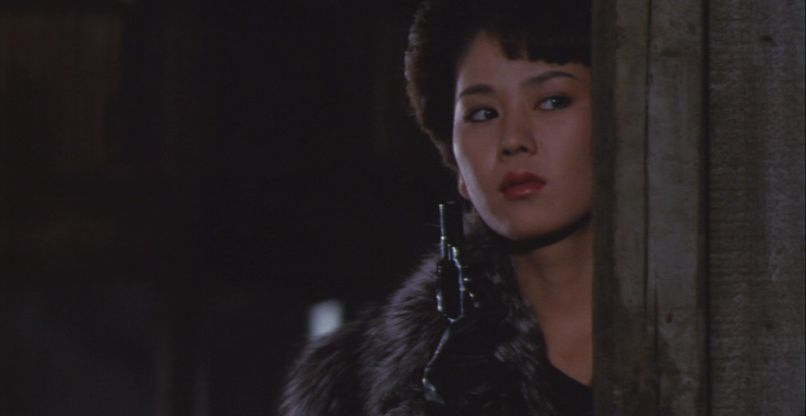
Meneko
Shingo Yamashiro - 1983
Impulse Pictures Region 1 DVD
Between the shootings and the general sense of nihilism, She Cat strikes me as being closer in spirit to the kind of movies Japan's Nikkatsu company produced in the late Fifties and early Sixties. With the exception of one of the minor characters, there's a bleak ending for everyone involved here. At the same time that the film may seem to look to the past with its story involving gangsters and corruption among the corporate elite, the sexual elements are relatively more adventurous than what is found on most Roman Porno.
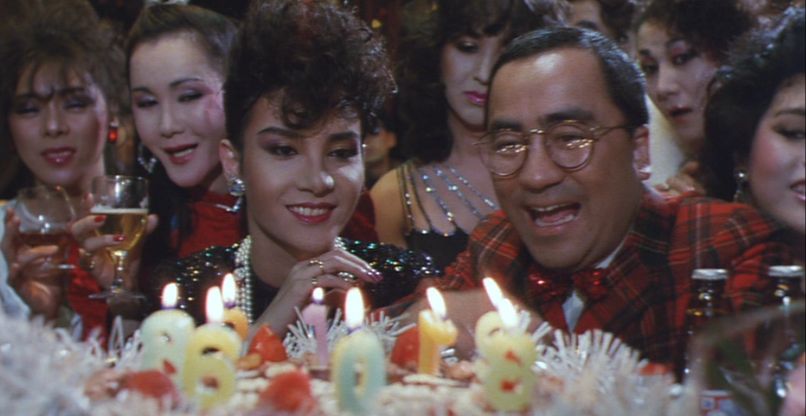
There are scenes of lesbian sex involving the three female doctors, two of whom are a couple running an Ob/Gyn clinic. The opening scene is of a man bringing his female impersonating wife, Tomiko, to the clinic to verify her pregnancy. The happy couple invites Dr. "Cat" Kagami to Tomiko's birthday party. Things take a turn for the worse for everyone when shots are fired into the crowded party, and the birthday girl is killed.
How much Shingo Yamashino and his writers Chiho Katsura and Makoto Naito deliberately cribbed from other outre filmmakers is unknown, but I just can't dismiss some things as coincidence. The sapphic scenes as well as uses of quick flashbacks made me think of Radley Metzger at his most self-consciously arty, while Tomiko's birthday party seemed like a nod to Russ Meyer's Beyond the Valley of the Dolls. There's even a vaginal point of view shot, something that I associate with Jess Franco. There's also some conventional heterosexual coupling for those who get off on that sort of thing.
What also makes She Cat unusual is that, with the exception of a Cat's friend in need, Charlie, the straight guys here are scum or just plain sleazeballs. Even without the rape and murder, these men are one unsavory bunch. The various strands of perversity make for one of the more unique films in Nakkatsu's Roman Porno series. Perhaps I am reading more than intended, but it could well be that in its idiosyncratic way, the film might be understood as criticism of the worst excesses of self-entitled male heterosexual privilege.
The only real misstep here is a synth driven score so cheesy I was afraid my lactose intolerance would flare up again. The worst of it is during a chase scene in Yokohama's Chinatown district with music more fitting for a no-budget kung fu movie by some fly by night company.
Ai Saotome displays her ample breasts, but for me is more electrifyingly sexy wearing a fur coat when out for revenge. Seeing her handle a gun or a scalpel, it's no surprise that Saotome was often cast as a villain. Writer Chiho Katsura's most famous credit is probably that masterpiece of nuttiness, House. Shingo Yamashiro directed a handful of films, but spent most of his forty-plus year career in front of the camera with roles in Thirteen Assassins and Graveyard of Honor among his more notable credits.
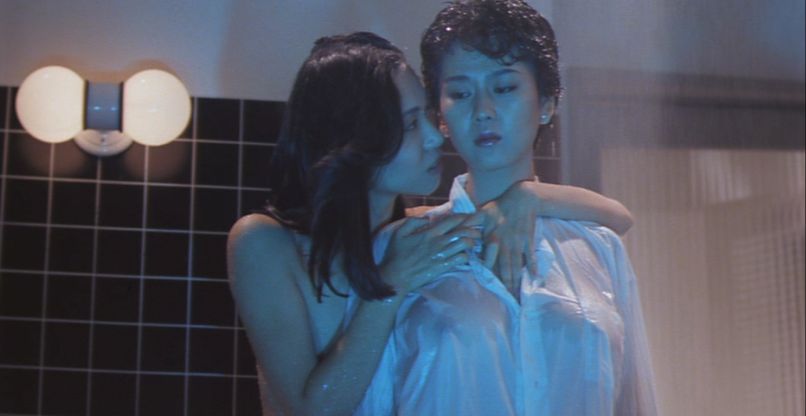
Posted by Peter Nellhaus at 07:03 AM
May 05, 2013
Coffee Break

Gus Schilling and Irving Bacon in It Started with Eve (Henry Koster - 1941)
Posted by Peter Nellhaus at 08:30 AM
May 02, 2013
Female Teacher Hunting

Onna kyoshi-gari
Junichi Suzuki - 1982
Impulse Pictures Region 1 DVD
During a moment of sex with her married lover, Shimako tells him, "Let's get nasty." Nasty might be a good operative word for much of this film. The narrative caters for that particular male audience which enjoys depictions of rape. The sex in this film is mostly furtive and joyless. As one of the latter Nikkatsu Roman Porno productions, it appears that production money was tightening with the use of grainier film stock, adding to the tonal darkness here.
The story hinges on a nasty rumor of a student raping a female classmate. Rather than clearing up the accusation, the student drops out of school, winding up in a small coastal town where he lives and works with a owner of a small restaurant and his openly available wife. Shimako also shows up at the town, attempting to continue her relationship with her lover.

There are times when one watches a movie that seems less than promising in the hopes that there is something that provides a payoff, at the very least a small moment of redemption. I don't know if it was deliberate, but there is one near perfect shot of Shimako and her lover sitting together in a car. There are hints that the relationship is not going well. The couple are seen sharing the same space within the car, underneath a bridge. Looking at the two through the front window, the reflection of light creates a jagged division between the two. The light shines on Shimako, while the lover is in a darker space. The visual qualities in this one shot reveal all that needs to be said about this couple in the kind of shot that would more likely be remarked upon in a film by a more seriously considered filmmaker.
Water also plays an important part in the narrative. The film begins and ends with nude swimming in the school's outdoor pool. Shimako encounters her lover with his family during a stroll on the beach. The cleansing power of water is literally shown with Shimako taking a shower. There are also some metaphorical implications with the restaurant owner keeping some guppies found swimming in dirty street water. The suggestion here is that sometimes one has to swim through dirty water and find ways to be adaptable to survive. That the baby guppies have to be separated from the parents to keep from being eaten reenforces the notion of social Darwinism at work.
As noted in his own website Junichi Suzuki was nominated as a best new director for Female Teacher Hunting. It could well be that culture and context play a part here, although Suzuki's post Roman Porno career is certainly impressive. Likewise, star Yuki Kazamatsuri has had a long career, most notably with an appearance in Kill Bill, Vol. 1.

Posted by Peter Nellhaus at 08:11 AM
